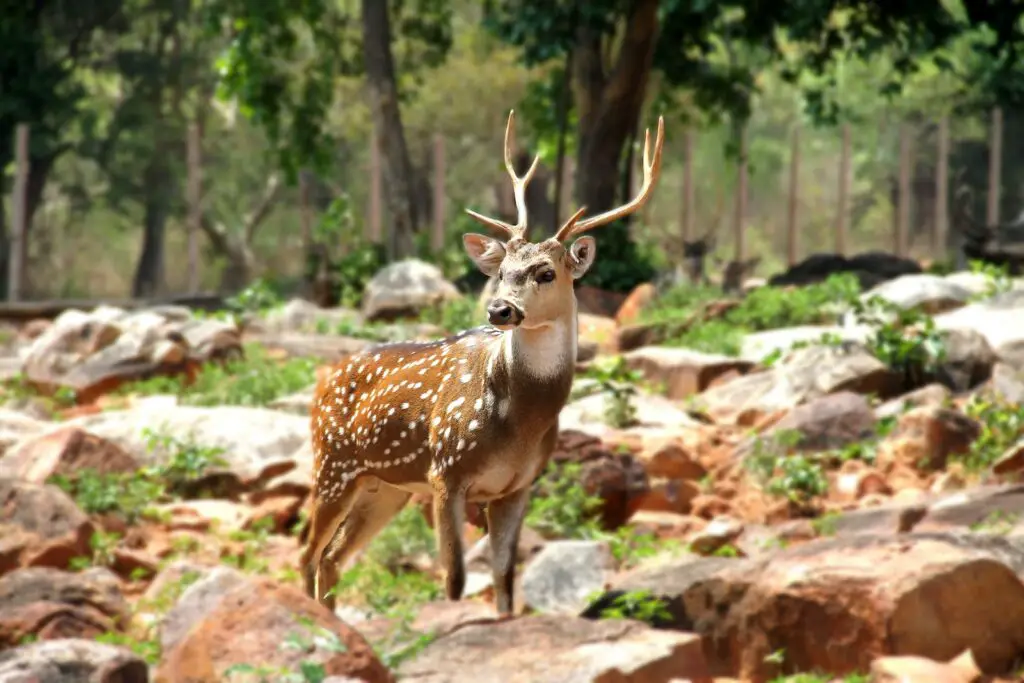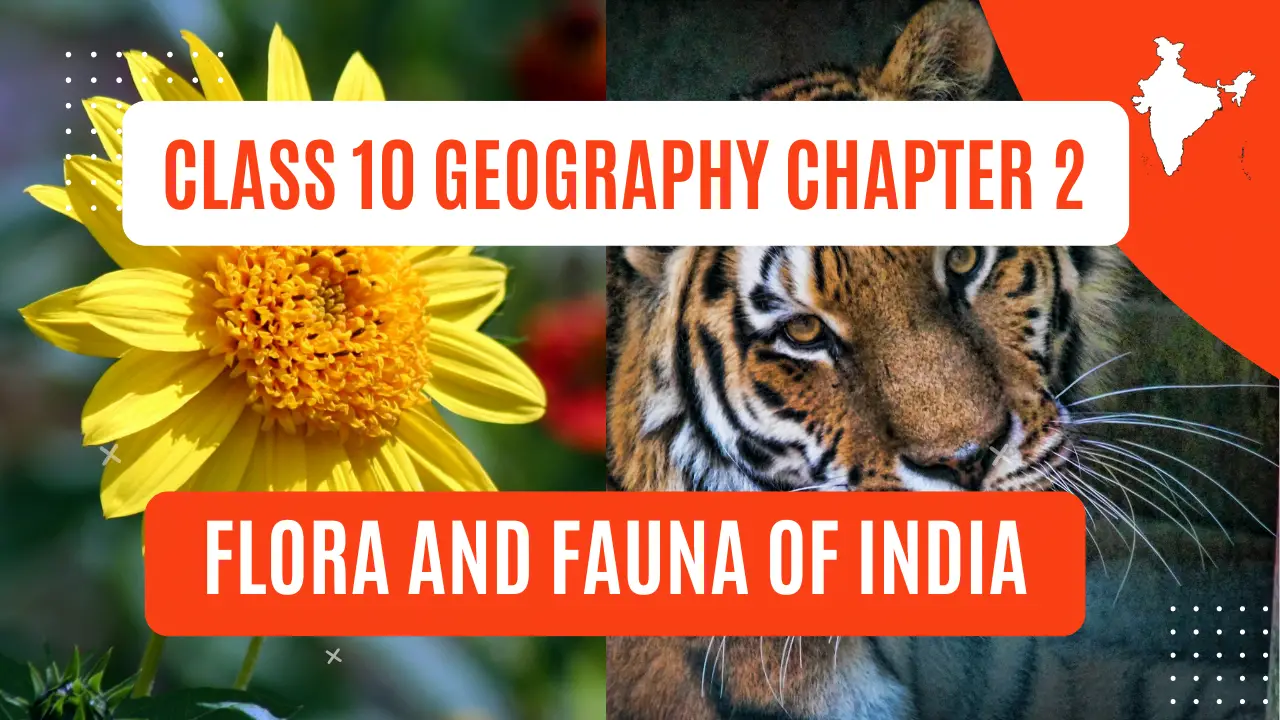The fascinating world of India’s flora and wildlife is explored in Class 10 Geography Chapter 2, along with its categorization, reasons for depletion, conservation efforts, distribution, and the complex interaction between communities and conservation. The natural world has a diverse array of flora and wildlife, making it a veritable treasure trove of diversity. The study of biodiversity is of utmost importance in the field of geography. The ecological treasures of India are showcased in this chapter, along with the pressing need to safeguard them.
Class 10 Geography Chapter 2
Detailed about Flora and Fauna of India.
1. Introduction to India’s Flora and Fauna
India, which is renowned for both its physical and cultural richness, is home to an astonishing variety of flora and animals. While fauna refers to the animal life existing in a certain area, flora refers to the plant life. India’s diverse climatic and geographical circumstances support an astounding range of living forms, from the snow-capped Himalayas in the north to the lush Western Ghats in the south, and from the parched Thar Desert in the west to the green forests in the east.
2. Specific species classification
A key idea in biology is the taxonomy of species. Class 10 Geography Chapter 2 examines the categorization of species from a geographical perspective. India may be classified into a number of biogeographical areas, each of which has its own distinct ecological characteristics. Different species that have adapted to these habitats can be found there. For instance, because of their remoteness and diverse climatic conditions, the Western Ghats are home to a large number of indigenous species.
The categorization of species transcends geographic bounds. Indian species may be divided into indigenous and alien species depending on where they came from. While exotic species are brought from other locations, native species are found there naturally. The introduction of alien species may frequently disturb the ecosystem’s equilibrium, which may have a negative effect on native species.
3. Causes of Flora and Fauna Depletion
Numerous man-made activities are threatening nature’s fragile equilibrium. Some of the major causes of the decline in flora and wildlife are deforestation, pollution, habitat degradation, and poaching. As a result of deforestation caused by urbanization, agricultural development, and industrialization, many species lose their essential habitats. Pollution, whether it be in the form of air, water, or soil contamination, has a negative impact on the health and survival of both plants and animals.
The loss of biodiversity is inextricably connected to habitat degradation. Species struggle to find acceptable living circumstances as natural habitats are changed or destroyed, which causes a drop in their numbers. Because illicit wildlife trafficking frequently fuels poaching, many fragile species are on the verge of extinction. Unless immediate action is taken, the combined effect of these issues portrays a bleak picture of the future.
4. Conservation of Forests and Wildlife in India

India has made considerable progress in the conservation of its abundant biodiversity after realizing the gravity of the problem. To guarantee that natural resources are available for future generations, conservation requires the sustainable management of such resources. The Wildlife Protection Act of 1972, which gave vulnerable animals and their habitats legal protection, represented a turning point in India’s conservation efforts.
National parks and wildlife refuges are examples of protected places that are essential to conservation. These areas serve as safe havens for different species, enabling them to flourish without interference from people. In order to protect these magnificent animals and recognize their significance in preserving the ecological balance, Project Tiger and Project Elephant were launched.
5. Forest and wildlife resource types and distribution

The different forest and animal resources in India reflect the country’s diversified terrain. According to the type of plant that predominates in the forest and its type, forests are classified. Some of the most common forest types in India are tropical rainforests, deciduous forests, coniferous forests, and mangrove forests. Each of these habitats is home to a distinct group of organisms that have evolved to survive there.
Various species, including mammals, birds, reptiles, amphibians, and insects, are included in the category of wildlife resources. India’s wildlife thrives all across the country, not only in protected regions. The Ganges and Brahmaputra rivers, for instance, are the habitat of the Gangetic dolphin, an endangered species. The availability of appropriate habitats and ongoing conservation efforts are directly related to the distribution of animal resources.
6. Conservation and the Community
The central theme of Class 10 Geography Chapter 2 is the complex interaction between communities and conservation. Indigenous peoples have lived in harmony with nature for millennia, and they have accumulated traditional knowledge about resource management that is sustainable. Their methods are based on the concept that human and natural well-being are connected. This native knowledge is a priceless source for contemporary conservation tactics.
The effectiveness of conservation projects depends on community participation. The land and its riches are well-known to the local populations. Participating in conservation initiatives with them not only assures the survival of biodiversity but also fosters socioeconomic growth. The Chipko Movement is a prime example of grassroots environmental action since it grew out of the connection that people had with their woods.
7. Maintenance of India’s Ecological Heritage
Class 10 Geography Chapter 2, “Flora and Fauna of India,” provides a thorough analysis of India’s exceptional biodiversity and emphasizes the pressing need for its conservation. Every habitat, from the coastal mangroves to the tundra of the Himalayas, is proof of the inventiveness of nature. However, the activities of humans pose immediate challenges to this variety.
Conservation is a duty that spans generations rather than a luxury. The delicate balance of our ecosystems has to be preserved, and everyone—from individuals to governments—must work together to do this. We can create a route towards sustainable cohabitation with the environment by comprehending the factors that lead to depletion, the importance of protected areas, and the knowledge of indigenous cultures.
Class 10 Geography Chapter 2 challenges us to go beyond our geography textbooks and engage with the natural world around us as geographers. It motivates us to inquire, acquire knowledge, and take an active part in the continuous story of conservation. By preserving India’s natural history, we open the door to a peaceful future where a variety of species coexist peacefully, ecosystems thrive, and future generations may take in the wonders of nature.









